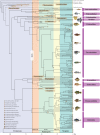Mass extinction in tetraodontiform fishes linked to the Palaeocene-Eocene thermal maximum
- PMID: 29118135
- PMCID: PMC5698648
- DOI: 10.1098/rspb.2017.1771
Mass extinction in tetraodontiform fishes linked to the Palaeocene-Eocene thermal maximum
Abstract
Integrative evolutionary analyses based upon fossil and extant species provide a powerful approach for understanding past diversification events and for assessing the tempo of evolution across the Tree of Life. Herein, we demonstrate the importance of integrating fossil and extant species for inferring patterns of lineage diversification that would otherwise be masked in analyses that examine only one source of evidence. We infer the phylogeny and macroevolutionary history of the Tetraodontiformes (triggerfishes, pufferfishes and allies), a group with one of the most extensive fossil records among fishes. Our analyses combine molecular and morphological data, based on an expanded matrix that adds newly coded fossil species and character states. Beyond confidently resolving the relationships and divergence times of tetraodontiforms, our diversification analyses detect a major mass-extinction event during the Palaeocene-Eocene Thermal Maximum (PETM), followed by a marked increase in speciation rates. This pattern is consistently obtained when fossil and extant species are integrated, whereas examination of the fossil occurrences alone failed to detect major diversification changes during the PETM. When taking into account non-homogeneous models, our analyses also detect a rapid lineage diversification increase in one of the groups (tetraodontoids) during the middle Miocene, which is considered a key period in the evolution of reef fishes associated with trophic changes and ecological opportunity. In summary, our analyses show distinct diversification dynamics estimated from phylogenies and the fossil record, suggesting that different episodes shaped the evolution of tetraodontiforms during the Cenozoic.
Keywords: FBD model; K-Pg; Palaeogene; RPANDA; spiny-rayed fishes.
© 2017 The Author(s).
Conflict of interest statement
We have no competing interests.
Figures




References
-
- Slater GJ, Harmon LJ, Freckleton R. 2013. Unifying fossils and phylogenies for comparative analyses of diversification and trait evolution. Methods Ecol. Evol. 4, 699–702. (10.1111/2041-210X.12091) - DOI
MeSH terms
LinkOut - more resources
Full Text Sources
Other Literature Sources
Medical
Miscellaneous

